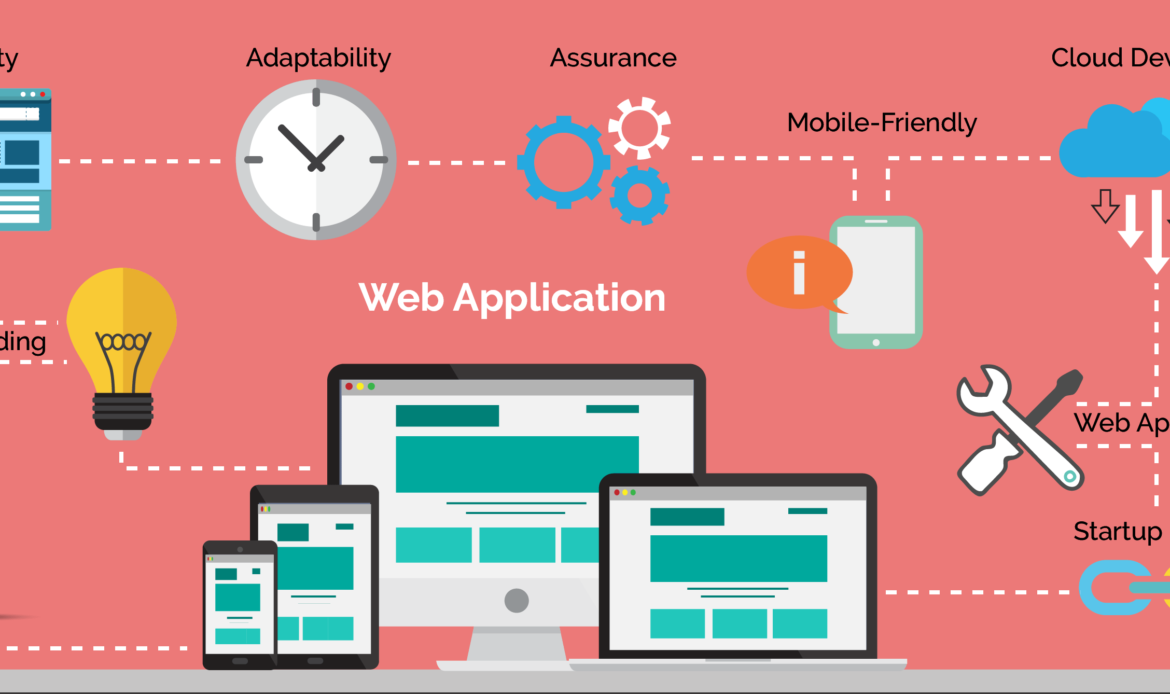
Web and App Development encompasses a broad spectrum of technologies and practices used to create websites and mobile applications. This field is dynamic and constantly evolving, driven by advancements in technology, changing user behaviors, and emerging trends. Here’s a comprehensive overview to get you started:
1. Web Development
a. Frontend Development
Frontend development focuses on the part of the website that users interact with directly. It involves designing and building the visual elements of a website, including layout, navigation, graphics, and interactivity.
- Languages & Frameworks:
- HTML (HyperText Markup Language): The standard language for creating web pages.
- CSS (Cascading Style Sheets): Used to style and layout web pages.
- JavaScript: A programming language that enables interactive features.
- Frameworks & Libraries:
- React.js: A JavaScript library for building user interfaces, maintained by Facebook.
- Vue.js: A progressive JavaScript framework for building UIs and single-page applications.
- Angular: A platform and framework for building client-side applications, maintained by Google.
- Svelte: A relatively new framework that compiles components into highly efficient JavaScript code.
- Tools & Technologies:
- Version Control: Git, GitHub, GitLab.
- Package Managers: npm, Yarn.
- Build Tools: Webpack, Babel.
- CSS Preprocessors: Sass, LESS.
b. Backend Development
Backend development focuses on the server-side, managing the database, server logic, and application integration. It ensures the frontend can access the necessary data and functions.
- Languages & Frameworks:
- JavaScript (Node.js): Enables JavaScript to be used for server-side scripting.
- Python (Django, Flask): Popular for its simplicity and readability.
- Ruby (Ruby on Rails): Known for its convention over configuration approach.
- PHP (Laravel): Widely used for server-side development.
- Java (Spring Boot): Enterprise-level backend framework.
- C# (ASP.NET): Used for building web apps on the Microsoft platform.
- Databases:
- SQL Databases: MySQL, PostgreSQL, SQLite.
- NoSQL Databases: MongoDB, CouchDB, Redis.
- APIs & Services:
- RESTful APIs: Architectural style for building web services.
- GraphQL: A query language for APIs.
- Authentication & Authorization: OAuth, JWT.
c. Full-Stack Development
Full-stack developers work on both the frontend and backend, understanding the full spectrum of web development. They are proficient in a wide range of technologies and can build complete web applications.
2. App Development
a. Native App Development
Native apps are built specifically for a particular mobile operating system, either iOS or Android.
- iOS Development:
- Language: Swift, Objective-C.
- Tools: Xcode, Interface Builder.
- Android Development:
- Language: Kotlin, Java.
- Tools: Android Studio, Gradle.
b. Cross-Platform App Development
Cross-platform apps are developed to run on multiple operating systems using a single codebase.
- Frameworks:
- React Native: Uses JavaScript and React to build mobile apps.
- Flutter: Uses Dart language, developed by Google.
- Xamarin: Uses C# and .NET framework.
- Ionic: Uses web technologies (HTML, CSS, JavaScript).
c. Progressive Web Apps (PWAs)
PWAs are web applications that offer a native app-like experience using modern web capabilities. They can be accessed through a web browser and installed on a device like a traditional app.
- Technologies:
- Service Workers: Enable offline functionality and push notifications.
- Web App Manifest: Provides metadata for the app, like the name, icon, and theme color.
- Responsive Design: Ensures the app looks good on any screen size.
3. Development Practices and Methodologies
- Agile Development: Iterative and incremental development methodology that promotes flexible responses to change.
- DevOps: Integrates development and operations to improve collaboration and productivity by automating workflows and continuous delivery.
- Test-Driven Development (TDD): Writing tests before writing the code to ensure functionality is as expected.
- Continuous Integration/Continuous Deployment (CI/CD): Automating the process of testing and deploying code.
4. Web & App Security
Ensuring the security of web and mobile applications is crucial. This involves protecting against a range of threats, including:
- SQL Injection: Malicious SQL code can manipulate or access the database.
- Cross-Site Scripting (XSS): Injection of malicious scripts into web pages viewed by other users.
- Cross-Site Request Forgery (CSRF): Forcing a user to execute unwanted actions on a web application.
- Secure Authentication: Using secure methods for login, such as hashing passwords and using multi-factor authentication.
5. Trends in Web & App Development
- Artificial Intelligence & Machine Learning: Integrating AI and ML to create smarter applications.
- Voice Search & Navigation: Building applications that can be controlled via voice commands.
- Motion UI: Creating rich animations and transitions in apps to enhance user experience.
- Blockchain: Implementing decentralized applications and enhancing security.
- Internet of Things (IoT): Developing applications that interact with smart devices.
6. Tools & Resources
- IDEs & Code Editors: VSCode, Atom, Sublime Text.
- Version Control Systems: Git, Mercurial.
- Design & Prototyping Tools: Figma, Sketch, Adobe XD.
- Debugging Tools: Chrome DevTools, Postman.
- Performance Testing Tools: Lighthouse, WebPageTest.
7. Getting Started & Learning Resources
- Online Courses: Platforms like Coursera, Udemy, and Codecademy offer courses in various web and app development technologies.
- Documentation & Tutorials: Official documentation for frameworks and languages (e.g., MDN Web Docs, React Docs) are invaluable resources.
- Communities & Forums: Stack Overflow, Reddit, and GitHub discussions provide a place to ask questions and share knowledge.
- Practice Platforms: LeetCode, HackerRank, and Codewars offer coding challenges to hone your skills.
Summary
Web and app development is a multifaceted field that requires a blend of creativity and technical skills. Whether you’re focusing on building the next breakthrough mobile app or crafting a visually stunning website, understanding the fundamentals and staying updated with the latest trends and technologies is crucial for success
